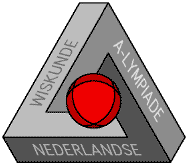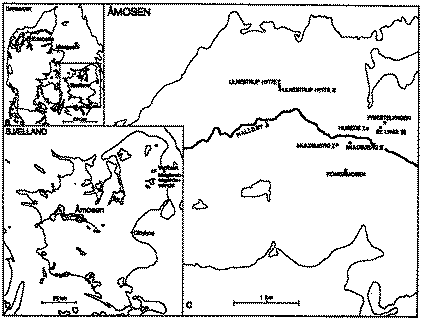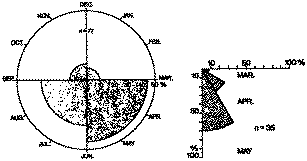 Math A-lympiad:
Final 1991-1992
Math A-lympiad:
Final 1991-1992
Denmark the border
Introduction
In the Mesolithic, people from Middle Europe moved to the northern parts
of Europe in spring time - where the snow started melting by then - to
find food. One assumed that they did not get northern of Middle Germany.
Recent findings however, lead to a possible new view of this issue.
Not that long ago, researchers came to the following statement: "During
the Mesolithic, peoples from Middle Europe moved farther north in spring
and summer time, than was assumed till recently. Actual research findings
lead to the conclusion that not Middle Germany was the northern border,
but Denmark formed the border of their territories."
Exercise
Support or reject this statement, based on the information you can find
on the following pages. After you are finished you should hand in:
-
An article or report (e.g., for a newspaper or a journal) in which you
make use of graphical representations the best way you can.
-
An appendix, that is separate from the article. That means, that you are
not allowed to refer to the appendix in the article. The appendix should
make clear how the thinking and reasoning process took place - e.g., you
can describe what you have done with the information of each page - and
it should contain a justification of the way you have worked.
Comments on the data that you would have liked to have had, and suggestions
for more research to reject or support the statement can be included in
one of the two (article or appendix), or in only the article or only the
appendix.
Annual rings
Most people know about annual rings in trees. If you cut a tree, you see
the annual rings clearly as concentric curves. The number of rings determine
the age of a tree; the thickness of a ring gives some information about
the growth process during the corresponding year, and thus about the weather
in that year.
Shells have very easy to recognize growth rings as well, as have bones.
However, the rings of shells and bones are harder to distinguish. Below
you see examples of annual rings for trees, shells and pike bones.
 |
Examples of annual rings
Based on the annual rings, you can give an indication of when the tree,
the shell, or the animal died. In spring - when a new ring just starts
- in summer, etc.
Research
Fourteen pikes were killed for scientific reasons, and were very accurately
measured. The total length, the height without fin, and the jawbone were
measured for each of the fourteen fishes. The results in mm are in the
following tabel:
| Pike |
Length |
Height |
Jawbone |
| S1 |
760 |
135 |
110 |
| S2 |
602 |
99 |
85 |
| S3 |
612 |
102 |
88 |
| S4 |
743 |
127 |
101 |
| S5 |
479 |
80 |
66 |
| S6 |
543 |
91 |
77 |
| S7 |
588 |
96 |
80 |
| S8 |
661 |
122 |
97 |
| S9 |
708 |
130 |
101 |
| S10 |
751 |
133 |
111 |
| S11 |
659 |
124 |
96 |
| S12 |
559 |
93 |
80 |
| S13 |
601 |
100 |
83 |
| S14 |
539 |
90 |
75 |
Mesolithic
Mesolithic: Period in the pre-history between the Paleolithic and the Neolithic
(about 10000 to 8500 BC - about 5000 BC).
The Mesolithic is characterized by a warming trend in the climate of
Western Europe. Steppe and tundra were replaced by prairie and grass lands
with large open areas. Ordinary deer became the most important animal,
and the reindeer moved northward. People used small stone tools, and had
dogs as pets. Hunting remained important, but fishing and especially fishing
and collecting snails and shells were quite important activities for gathering
food. People no longer lived in caves or under large rocks, but built huts
and established large villages.
The Mesolithic civilization shows some common features, but were actually
quite divers. The most important cultures were the Maglemose (most Northern
Europe), the Azilien, Tardenoisien and Campagnien (France), and the Capsien
(Northern Africa).
One has only found a small number of human skeletons from the Mesolithic,
e.g. at Offenet and Kaufertsberg (Southern Germany), Mugum (Portugal),
and Teviec (Bretagne). The skeletons show only one common feature: the
small height (1.6 meters for men).
Jawbones
Researchers have searched intensively for bones that could give some indication
about the sizes of pikes in the Danish lake named Praestelygnen. The jawbones
(see drawing) of the pikes in that lake were the only bones that the researcher
could make reliable estimates about the length of. The following table
provides the estimated lengths of the jawbones of pikes in this lake. The
lengths are in mm.
| 73 |
35 |
65 |
71 |
66 |
45 |
55 |
56 |
48 |
77 |
39 |
65 |
67 |
49 |
| 81 |
58 |
74 |
66 |
69 |
59 |
55 |
63 |
61 |
77 |
79 |
84 |
80 |
49 |
| 77 |
74 |
83 |
83 |
59 |
39 |
73 |
91 |
63 |
71 |
72 |
59 |
64 |
69 |
| 74 |
29 |
88 |
35 |
74 |
79 |
67 |
59 |
77 |
83 |
81 |
53 |
48 |
69 |
| 67 |
39 |
78 |
77 |
73 |
91 |
66 |
57 |
87 |
67 |
87 |
65 |
49 |
58 |
 |
Esox Lucius
Cromer Lake
Archaeologists have found about 550 fish bones at excavations near Cromer
Laker in Germany. Half of these bones were bones of pikes. The researchers
were quite surprised because they were sure that the area around the lake
had never been inhabited, and that therefore the bones could not have been
rests of meals.
At a press conference, a public relations officer replied to the question
about the large numbers of pike bones. He said that cannibalism is quite
common among pikes, and that this could result in larger numbers of pike
bones than one could expect.
Another explanation can be found in the fact that pike bones are quite
hard, and do not decay as fast as the softer bones of prey fish. The exact
distribution was:
| Fish |
Pike |
Tench |
Perch |
Roach |
Other |
| Number |
277 |
163 |
33 |
6 |
71 |
Rests of bones
At excavations at a former lake in Denmark (Praestelyngen) one dug up many
rests of bones. Altogether about 5000 pieces, all from fish. Through scientific
dating techniques, one concluded that the bones were from the end of Mesolithic.
Scientists tried to recover what kind of fish the bones were of. According
to the informant, there were striking numbers of pikes, almost 80%. In
these days, pike was a popular meal.
The rest of the bones concerned prey fish, including perch, tench and
roach.
Denmark
Nowadays Denmark is green, nice, and very mild, but in former time - e.g.,
in the Mesolithic - it was far less pleasant. Denmark consisted of tundra
and steppes, and especially in winter it was not a good place to be.
There were many lakes filled with lots of fish.
Very common fish were: roach, perch, tench, rudd and pike.
Usually only a couple of percents of the fish population were pikes.
Large and small
Only large pikes are interesting for consumption. It is too bad that there
are usually not many large pikes in a lake. Until recently, one could only
guess about the distribution of the lengths over different length classes.
Some time ago, a whole lake was poisoned to gain insight in the distribution.
The pikes - that were only one percent of the total fish population - had
the following distribution:
80 percent of the pikes was "small", with a length between 10 and 25
cm, with a maximum around the 20 cm.
The other 20 percent was distributed equally amongst the other length
classes.
The largest pike was 77 cm.
 |
Map of Denmark
Graphs
Because growth is a cyclic process - after December comes another January
- one often uses circular shaped graphs when drawing graphs to represent
growth processes.
The researchers, who investigated - based on the rests of the bones
- the time of death of the pikes in the Praestelyngen Lake, made the following
graphs:
 |
Graph of the time of death of pikes in the Praestelyngen
Lake (in percentages)
Exercise
This representation can be subject to quite some critics. Communicate your
critics. You could take the following questions into account:
-
What would the graph look like if all pikes had died in the period March-June?
-
Do you get the same area for the gray circle parts?
-
What about the second graph: does the area of the month May indeed provide
information about the number of deaths in that month?
Besides giving answers to these questions, also give suggestions for better
graphs.
The pike
The pike is an aggressive fresh water fish with a long body, up to 1 meter,
a large mouth with many teeth. It belongs to the family of pike-a-likes.
The back fin and ass of the pike are planted quite at the end of the
body. The color is predominantly olive green to dark green, with dark spots
and stripes.
The pike eats mostly fish, but also frogs and little birds.
The pike lives on the Northern Hemisphere. It is a rare fish in Southern
Europe.
At an age of 2 years, pikes are mature. By then, they are 30 to 50 cm
tall. Pikes breed in the spring, March through May. Spawn is stuck to all
kinds of substrate. In this period the pike is easy to catch, and therefore
a popular object for anglers (quoted from Larousse Encyclopedia).
 Math A-lympiad:
Final 1991-1992
Math A-lympiad:
Final 1991-1992 Math A-lympiad:
Final 1991-1992
Math A-lympiad:
Final 1991-1992


